Taking more advantage of these glorious autumn days, we drove this 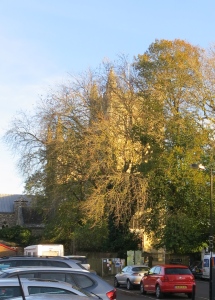
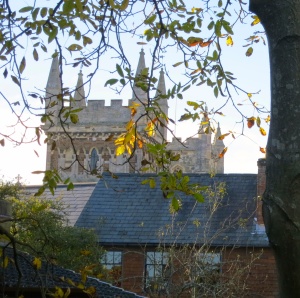 morning to Wimborne to visit The Priest’s House Museum and wander around the little town, including the Minster itself.
morning to Wimborne to visit The Priest’s House Museum and wander around the little town, including the Minster itself.
Somewhat surrounded by its environment, it is difficult to find a complete, unobstructed, view of the Minster, the greater part of which was built in the twelfth century. From wherever you are in the town, however; for example in the garden of the museum, or the car park nearby; at least one of its two towers is visible.
The splendid building is beautifully lit by its numerous stained glass windows, which set the very walls aglow.
The sheer scope of the stonework of the walls and windows is awe-inspiring, yet there is a lightness of touch that lifts the spirit.
 A niche in one of the internal walls contains the coffin of Anthony Et(t)ricke. A notice informs us that this clearly eccentric gentleman was convinced he would die in 1693 and had his intended coffin inscribed accordingly. In the event, he lived for another ten years, and when the time came to lay him to rest a rather unsuccessful attempt to change the date of decease to 1703 was made.
A niche in one of the internal walls contains the coffin of Anthony Et(t)ricke. A notice informs us that this clearly eccentric gentleman was convinced he would die in 1693 and had his intended coffin inscribed accordingly. In the event, he lived for another ten years, and when the time came to lay him to rest a rather unsuccessful attempt to change the date of decease to 1703 was made.
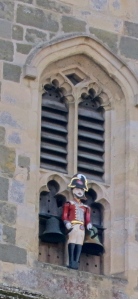 High up outside a window in one of the towers stands the Quarter Jack, now a symbol of Wimborne. He has for centuries stood watching over the town, and still, as he did for us waiting at 2.00 p.m., strikes his flanking bells with his hammers.
High up outside a window in one of the towers stands the Quarter Jack, now a symbol of Wimborne. He has for centuries stood watching over the town, and still, as he did for us waiting at 2.00 p.m., strikes his flanking bells with his hammers.
The visit to the Minster came after we had lunched in the cafe in the garden of The Priest’s House Museum after an enjoyable tour of that establishment. Another in a growing number of local history museums we have visited, this one is imaginatively conceived and executed, having both permanent displays and particular periodic exhibitions. It is, as we were to learn, a thriving activity centre for children who are encouraged to hunt for objects in the house and grounds, and to engage in activities, such as cooking on the kitchen range, that were undertaken in days gone by.
There are various rooms on the first floor, housing cabinets containing artefacts relevant to the history of East Dorset. 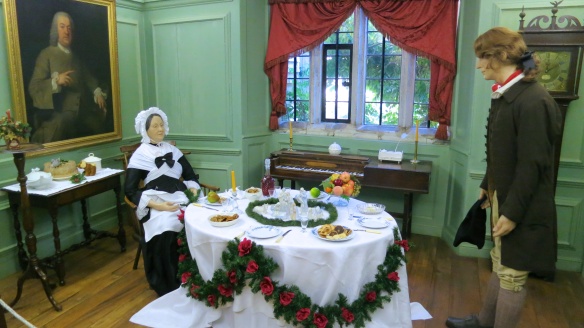 First of all, on the ground floor, there are rooms dedicated to tableaux, such as Mrs King’s parlour, where Elizabeth, a mercer’s widow is seen discussing building plans with John Mitchell, her master plumber, who is known to have worked on the site in the eighteenth century.
First of all, on the ground floor, there are rooms dedicated to tableaux, such as Mrs King’s parlour, where Elizabeth, a mercer’s widow is seen discussing building plans with John Mitchell, her master plumber, who is known to have worked on the site in the eighteenth century.
The schoolroom was fascinating.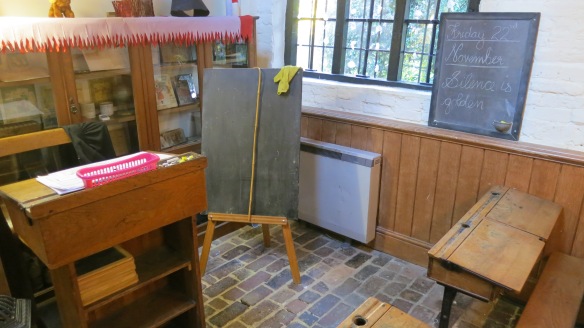 The cane hanging over the blackboard was an authentic touch. Today’s date, in fine copper plate handwriting, was inscribed on the blackboard. The plastic pencil container on the teacher’s desk was perhaps an aberration. What fascinated me was the pairs of desks, which enthralled two small children who, having visited earlier in the week, had brought their parents back for a second visit. Their eyes opened wide when I told them I had sat beside Maureen Potter in one of those very same desks when I had been a little boy.
The cane hanging over the blackboard was an authentic touch. Today’s date, in fine copper plate handwriting, was inscribed on the blackboard. The plastic pencil container on the teacher’s desk was perhaps an aberration. What fascinated me was the pairs of desks, which enthralled two small children who, having visited earlier in the week, had brought their parents back for a second visit. Their eyes opened wide when I told them I had sat beside Maureen Potter in one of those very same desks when I had been a little boy.
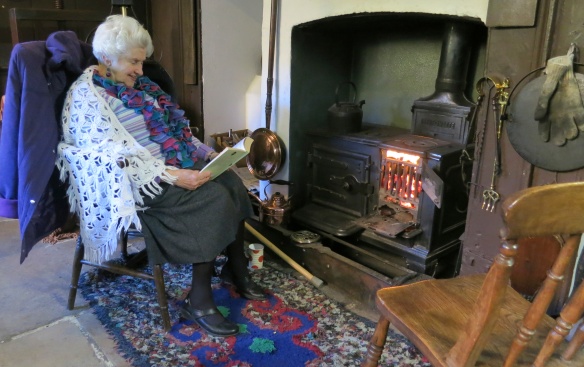 Moving on from this conversation, I entered the Victorian kitchen, laid out with all its accoutrements, complete with an elderly woman with a shawl round her shoulders and a book in her hands before a lighted kitchen range. This truly was an authentic tableau, with just one figure of the period in situ. Then she spoke. I laughed wholeheartedly, and said I had thought she was a model. She told me that a small boy earlier had thought the same thing, and had been most surprised when she greeted him.
Moving on from this conversation, I entered the Victorian kitchen, laid out with all its accoutrements, complete with an elderly woman with a shawl round her shoulders and a book in her hands before a lighted kitchen range. This truly was an authentic tableau, with just one figure of the period in situ. Then she spoke. I laughed wholeheartedly, and said I had thought she was a model. She told me that a small boy earlier had thought the same thing, and had been most surprised when she greeted him.
This was Margery Ryan who was clearly one of the volunteers, and a wealth of information, including that of the children’s activities. They were encouraged to make toast with one of the toasting forks hanging beside the kitchen range, just as I and my siblings had done by an open fire in our sitting room at Stanton Road.  I remembered how, on a coal fire, you had to take your hand away every now and again because it got pretty hot.
I remembered how, on a coal fire, you had to take your hand away every now and again because it got pretty hot.
We spoke for a long time, before and after we were joined by Jackie. Margery, contemporary with our friend Margery Clarke, was proud of the fact that her name was spelt the proper way.
Perhaps the greatest surprise to me was the sight of the very mangle in which I had trapped Chris’s finger when we were very small. I swear it was the same one. How it had made its way there I’ll never know.
Having finally torn myself away from Margery, I ventured upstairs. There was much to intrigue in the cabinets. It is strange to see everyday objects from your own lifetime consigned to museum cabinets.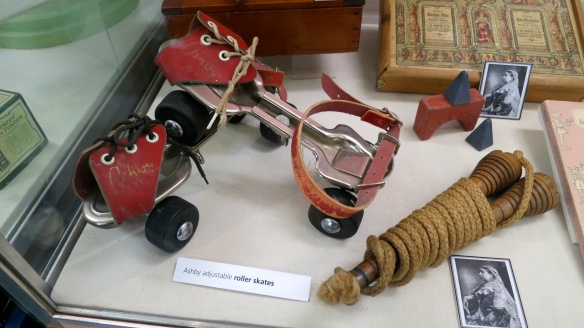 For example in the childhood room, side by side, lay the roller skates and skipping rope of the 1940s. Many a knee had I barked on the pavements of Stanton Road whilst trying to keep upright on my Ashby adjustable rollers; and we boys joined in all the girls’ skipping games and contests about who could do the most skips without tripping up.
For example in the childhood room, side by side, lay the roller skates and skipping rope of the 1940s. Many a knee had I barked on the pavements of Stanton Road whilst trying to keep upright on my Ashby adjustable rollers; and we boys joined in all the girls’ skipping games and contests about who could do the most skips without tripping up.
The 15th February 1971 was decimal day. This was when the pounds, shillings, and pence of our sterling currency made way for the coinage we have today. Overnight we had to learn that 244 pennies no longer made £1, for that was now divided into 100p. Interestingly we still use the old sterling symbol, £, for pound, but a penny is a p, not a d, the previous Latin abbreviation.  So it was fun to see a wallet in the gents’ costume gallery revealing £1 and 10 shilling notes. The largest of the coins resting on the open wallet was half a crown, eight of which made £1. This was quite a lot of money for a small boy. Especially one who bit his nails. Half a crown was the reward Auntie Gwen offered me to stop biting mine. I earned it. Then I bit them again. Then I earned it again. I think I tumbled to the idea of this being a good wheeze before my godmother did and that particular source of extra pocket money dried up.
So it was fun to see a wallet in the gents’ costume gallery revealing £1 and 10 shilling notes. The largest of the coins resting on the open wallet was half a crown, eight of which made £1. This was quite a lot of money for a small boy. Especially one who bit his nails. Half a crown was the reward Auntie Gwen offered me to stop biting mine. I earned it. Then I bit them again. Then I earned it again. I think I tumbled to the idea of this being a good wheeze before my godmother did and that particular source of extra pocket money dried up.
We vowed to return, especially as one admission ticket is good for a year’s season ticket, to see the long narrow garden in its prime. Apart from an interesting array of shrubs and flowers, it contains heritage apple and pear trees.
From the Minster we finally returned home. The lowering sun made even the A31 look delightful, 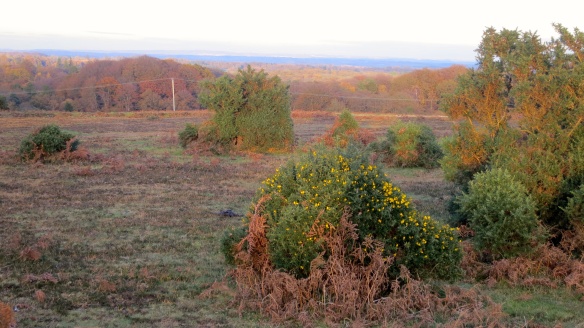

 and we took the Ocknell turn off so we could watch the last rays lighting up Stoney Cross Plain.
and we took the Ocknell turn off so we could watch the last rays lighting up Stoney Cross Plain.
 A small Shetland type pony turned its head disdainfully as two of its cousins demeaned themselves by forming the backdrop to a visitor’s photograph.
A small Shetland type pony turned its head disdainfully as two of its cousins demeaned themselves by forming the backdrop to a visitor’s photograph.
After a full day we tried out the Family House Chinese restaurant in Totton. The ambiance was homely, greeting warm and welcoming, the service friendly and efficient, and the food good. We both drank Tsingtao beer. We will go there again.


